In an age where environmental consciousness is more than just a trend, it’s a way of life, selecting everyday products that align with sustainable practices has become crucial. Water bottles, an essential item for hydration, have seen a significant makeover from being mere containers to eco-friendly accessories.
The specific type of product in focus, eco-friendly water bottles, harness materials like stainless steel, glass, or biodegradable substances that are durable and have a lower ecological impact over their lifecycle.
I approach this just like I do any thorough examination—I ask the right questions, scrutinize materials, and consider usability to piece together what truly makes the best eco-friendly water bottle.
As I transition into my findings, remember that the best pick isn’t just about what’s good for the planet, but also what best fits your daily routine and personal style.
- Best Overall: LARQ Bottle Swig Top 680ml
- Best Large Capacity: Takeya Actives 64oz
- Top Insulated Water Bottle: Owala FeeSip
- Best Mid-Sized Bottle: Takeya Actives 24oz
- Best Water Jug for Hydration: HydroJug Traveler
- Best Smart Water Bottle: Hidrate Spark PRO
1. LARQ Bottle Swig Top
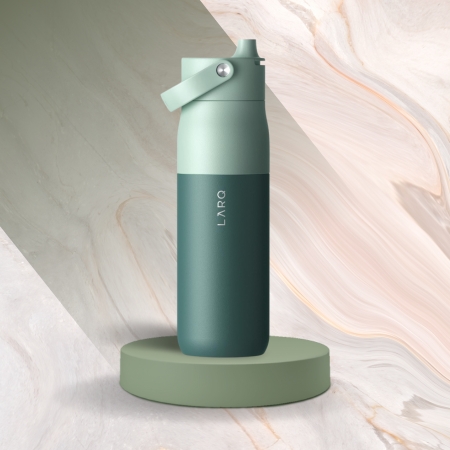
At daybreak today, I grabbed my LARQ Bottle filled with icy water. In the midday heat, my drink was still refreshingly cool, that double-wall vacuum insulation proving its worth. The matte finish on the bottle – velvety to the touch – managed to catch a few admiring eyes during my commute. I particularly enjoyed the magnetic cap.
While hydrating post-run, it meant no distracting cap flapping around. And can we talk about the grip? The smooth silicone loop ensured the bottle was glued to my hand while I dashed through my errands. This evening during cleanup, I lamented its hand-wash-only nature.
And while I’m enamored with its aesthetics, I am slightly wary of how long the hinge will remain intact. But for now, sipping from the LARQ feels as if it’s the missing piece to my daily routine – whether it’s for sports, travel, or just staying quenched amidst the hustle. For all these reasons, this is the one I use at the moment.
- Keeps water chilly for the entirety of a scorching day
- The cap’s design secures the spout without leaks
- Soft handle makes it a breeze to carry
- The hinge mechanism is not as durable
- Requires hand-washing
2. Takeya Actives 64oz
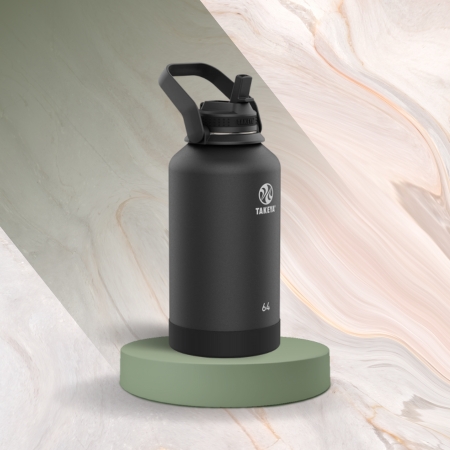
Filling Takeya Actives 64oz with ice water keeps consumers refreshed, even after a lengthy workout session. The double-wall design lived up to its promise, freeing me from the discomfort of a sweaty exterior common with lesser bottles.
The straw lid was a standout feature. It allowed for easy sipping without disrupting my exercises. Nothing is more grating than pausing mid-stride to unscrew a cap, but with Takeya’s design, hydration was seamless and spill-free, an absolute necessity for keeping the rhythm of my routine unbroken.
Toting it around proved to be a slight workout in itself. Although, the trade-off was a significant amount of water on hand, which meant fewer refills and more focus on my activity. Cleaning it wasn’t a hassle for me personally, but some might prefer a simpler maintenance option.
- Leak-proof design prevents any spills
- Maintains drink temperatures effectively
- Sweat-free exterior keeps it easy to handle
- May be heavy for some users when full
- Bulky size could be challenging to carry on-the-go
3. Owala FreeSip
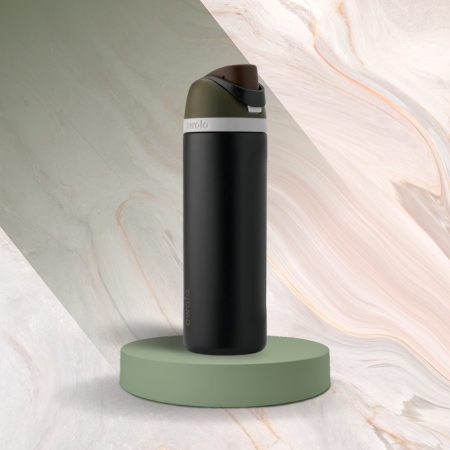
Owala FreeSip’s insulation is just as claimed, keeping my water chilled from sunup till sundown. The feature-packed design, from the built-in straw to the dual drinking modes, adapts to whether I feel like leisurely sipping or taking a quick gulp.
The locking button lid is a standout feature, guarding against accidental spills inside my backpack, a life-saver when I’m hauling electronics. Carrying it to meetings or when hitting the trail, the integrated loop makes it easy to hook onto my gear.
The cap snaps open with a push, which means I can reach for a drink without losing my stride. It fits comfortably in my car’s cup holder, so I’ve got cool water at hand when I’m on the road. The only hiccup is the girth of the bottle.
It can be a stretch for a hand, more so on the move. I do see how the inability to handle them might turn away some potential users. And though I appreciate quality, I can recognize that the Owala FreeSip is a bit of an investment—still, I’m of the mind that it’s worth it for a durable, eco-friendly bottle that cuts down on single-use plastics.
- Fits any preference
- Insulation keeps beverages cold
- Locking feature grants peace of mind
- A bit too wide for one-handed grip for some
- Limited to cold drinks
4. Takeya Actives 24oz
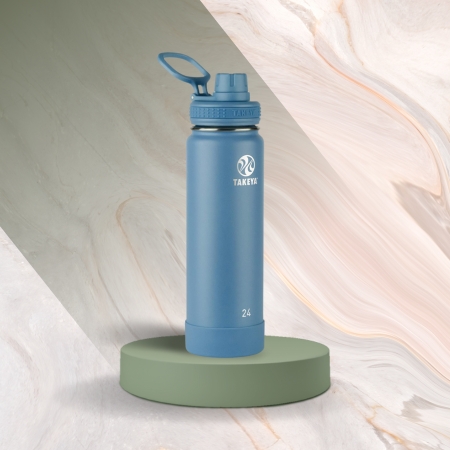
After using the Takeya Actives bottle, I appreciate how my water stays refreshingly cold, thanks to its vacuum insulation, even when the sun is relentless. Its double-wall construction means no more annoying condensation, keeping my hands and bag dry. The leak-proof lid is something I now can’t live without.
Tossing the bottle in my bag without worrying about spills has given me peace of mind. Plus, I’m quite fond of the easy-open spout which allows for a quick sip without interrupting my stride. But this bottle isn’t without drawbacks.
It does add a bit of weight to my daily carry, so if you’re not looking for a workout, this might be something to consider. It’s stout, so getting it to fit snugly in my car cupholder can be a challenge. And while I like the sleek onyx design, those who prefer a bit of pizzazz might find it a bit bland.
- Keeps my water ice cold for hours
- The leak-proof lid
- Easy grab-and-go option
- Fitting it in my car’s cupholder is challenge
- The plain design might not catch everyone’s eye
5. HydroJug Traveler
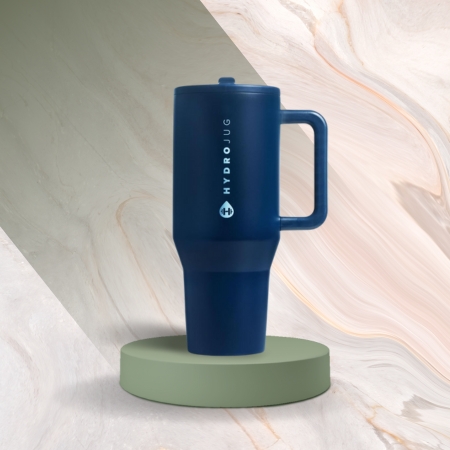
The HydroJug Traveler was my companion for both workouts at the gym and long car trips for some time. Its ambidextrous lid and circular flip straw were well-thought-out, enabling me to hydrate effortlessly from either hand while keeping my focus on the task.tium
Durability is key for an active lifestyle, and I appreciated the sturdy, leak-proof design with a non-slip rubber base. This meant that whether I was on a hike or navigating a crowded subway, I could trust my HydroJug to avoid any messy spills.
I had been careful, but a slight drop could threaten the integrity of the bottle. Moreover, though I hadn’t needed it myself, I noted from fellow users that reaching out to customer service may require some patience.
- Keeps drinks at the desired temperature
- Doesn’t leak
- Fits snugly in car’s cup holder
- Potential wear after few weeks
- It may not withstand drops
6. Hidrate Spark PRO
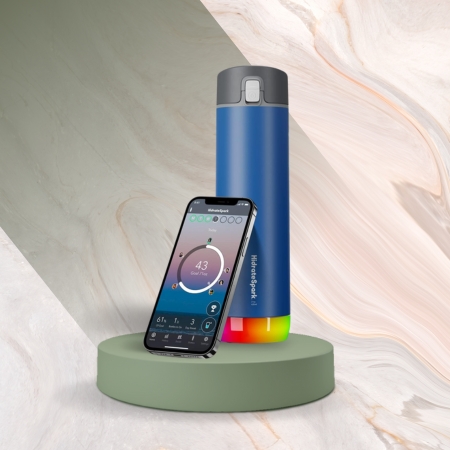
Initially, I was skeptical about technology being a part of something as simple as drinking water. But after testing out the Hidrate Spark PRO, I found quite a charming ally in my daily routine. With its intuitive glowing reminders, it’s been impossible to ignore when it’s time for a drink.
The cool sips hours after filling the bottle also indicate the vacuum-insulated stainless steel lives up to its promise. The real surprise was the level of customization available. Adjusting the glow colors and light patterns made hydrating a more personal experience.
And while initially nonchalant about the ‘find my bottle’ feature, after a few forgetful moments leaving it in the gym and the office, the feature proved its worth. I must say that the maintenance of charging and ensuring connectivity with my smartphone was a bit of a hassle.
Though it’s not every day you need to charge a water bottle, when the time comes, it feels cumbersome. The cost is another factor – it stands on the higher end of the water bottle market, which may deter some budget-conscious buyers.
Plus, while the free version of the app offers plenty, there’s always that niggling thought of ‘additional costs’ for the full experience.
- Encourages regular hydration
- Keeps water cold for the whole day
- Tracks last location
- Requires charging and Bluetooth connectivity
- Pricier than typical water bottles
Buyer’s Guide
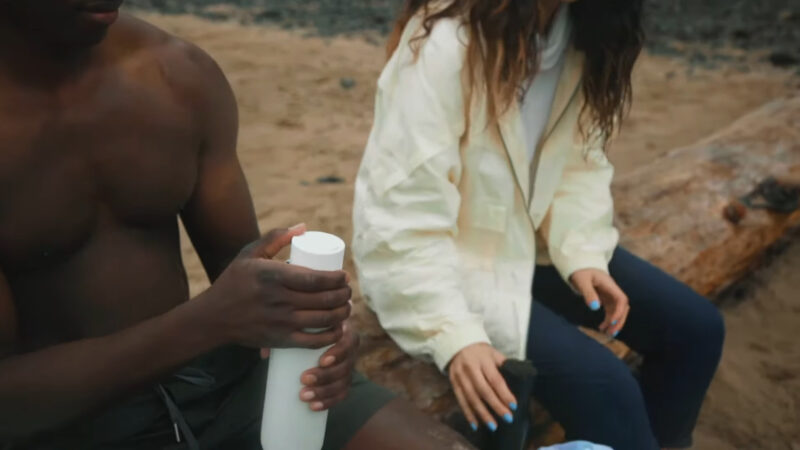
Selecting the right eco-friendly water bottle can be a rewarding yet challenging task. To assist you in making an informed decision, I will guide you through the key factors to consider. These factors are crucial in choosing a bottle that not only meets your daily hydration needs but also aligns with your environmental values.
Material
The choice of material is something you cannot do without. It’s a decision that impacts not only personal health but also the well-being of our planet. The ideal material for a water bottle should be safe for daily use, durable, and environmentally friendly.
With so many options available, food-grade stainless steel and glass stand out for their exceptional qualities.
Food-Grade Stainless Steel
This material is a top contender for several reasons. Firstly, it’s incredibly durable, resisting dents and breakage, which makes it a long-lasting choice. This durability also means a reduced need for frequent replacements, lessening environmental impact.
Stainless steel is inherently free from harmful chemicals like BPA, a common concern in some plastics. Additionally, it doesn’t retain or impart flavors, ensuring that your water tastes pure with each sip. Another significant advantage of stainless steel is its recyclability.
It can be recycled multiple times without degradation in quality, making it a sustainable choice for eco-conscious consumers.
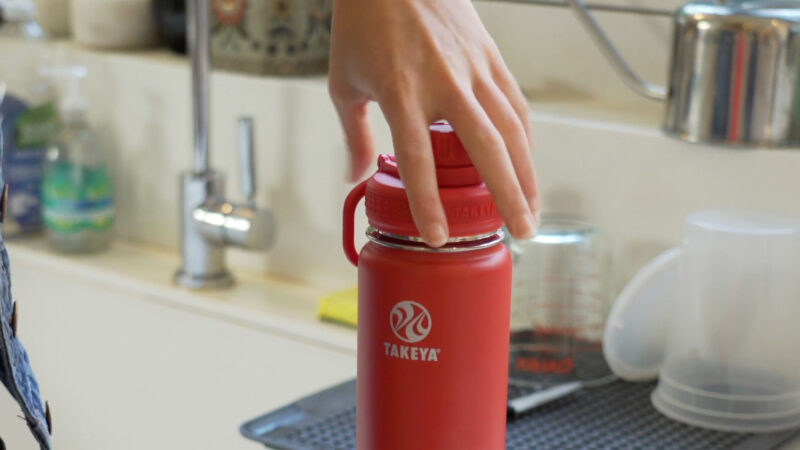
Glass
Glass is another excellent choice for those prioritizing health and sustainability. One of its primary advantages is its chemical inertness; glass does not leach chemicals into your water, ensuring the purity of the beverage. It’s also free from BPA and other potentially harmful substances found in some plastic bottles.
Glass bottles offer a level of transparency and aesthetic appeal that many users appreciate. While they are heavier and more fragile compared to stainless steel, many glass bottles come with protective silicone sleeves to mitigate breakage risks.
Glass is also 100% recyclable, contributing to environmental sustainability. When recycled, glass can be reused endlessly without loss in quality or purity, making it an environmentally responsible choice.
Insulation
Insulation in water bottles is a key feature for anyone who values maintaining their beverage at a consistent temperature over time. This is particularly important for individuals who are frequently on the move or who don’t have regular access to a fridge or a kettle. Sometimes you will need to undent the flask to make the insulation operate properly.
The technology behind insulated bottles is quite remarkable. The most effective insulated bottles use a double-walled construction.
Here’s how it works:
- Double-Walled Construction: This involves having two layers of material, usually stainless steel, with a vacuum space in between. This vacuum acts as a barrier, preventing heat transfer by conduction. As a result, the temperature on one side of the wall (the beverage side) doesn’t significantly affect the temperature on the other side (the outside environment).
- Temperature Retention: The result is excellent temperature retention. Hot drinks like coffee or tea can stay warm for hours, while cold beverages like water or iced tea remain chilled. This makes these bottles ideal for a variety of settings, from outdoor adventures to long days at the office.
- Versatility: While primarily used for water, these bottles can be used for a variety of beverages, making them versatile additions to your daily routine.
However, it’s important to note that insulated bottles do have some trade-offs:
- Weight: Due to their double-walled construction, these bottles are generally heavier than their non-insulated counterparts. This might be a consideration for those who are sensitive to carrying extra weight or who have limited space in their bags.
- Size: Insulated bottles may also be bulkier. The space taken by the vacuum insulation reduces the volume available for the liquid without increasing the overall size of the bottle.
Despite these trade-offs, the benefits of having a beverage at the ideal temperature throughout the day are significant for many people. Insulated bottles offer a convenient solution for those who want to enjoy their drinks just the way they like them, whether hot or cold, without the need for frequent reheating or additional ice.
Capacity
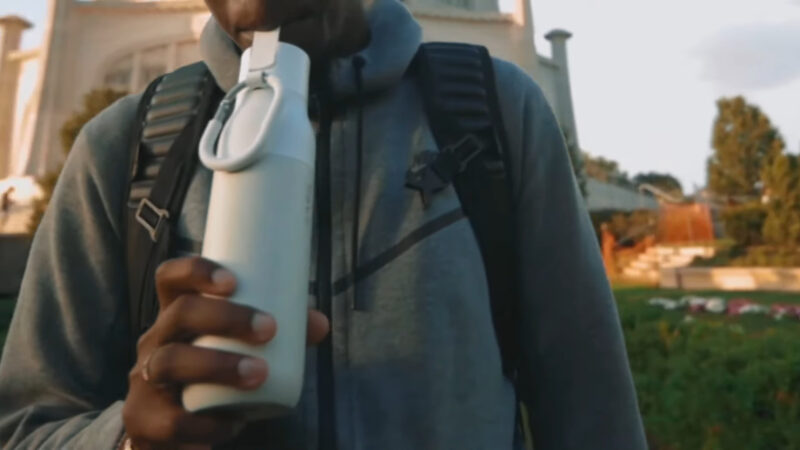
The capacity of a water bottle is a crucial aspect to consider, as it directly relates to how well it meets your hydration needs throughout the day. Water bottles come in a variety of sizes, and selecting the right one depends on several factors.
- Range of Sizes: Typically, water bottle capacities range from 16 ounces (about 473 ml) to 32 ounces (approximately 946 ml). Smaller bottles are lighter and more portable, making them a convenient choice for short trips, office use, or for children. Larger bottles, on the other hand, are ideal for those who need more water throughout the day without constant refills, such as athletes, outdoor enthusiasts, or people with a busy lifestyle.
- Hydration Needs: Your individual hydration needs are influenced by various factors like your activity level, climate, and personal health requirements. For instance, if you are physically active or live in a hotter climate, you may need a larger bottle to ensure adequate hydration.
- Portability and Convenience: While a larger bottle provides the benefit of carrying more water, it also means dealing with more weight and bulk. This can be a significant factor if you’re carrying the bottle in a backpack or handbag, or if you have limited storage space. Smaller bottles are easier to carry and fit in car cup holders, bike bottle cages, and side pockets of backpacks.
- Refills Frequency: Another factor to consider is the availability of water sources throughout your day. If you have frequent access to water for refills, a smaller bottle might suffice. However, if you’re going to be in places where water isn’t readily available, a larger bottle is more practical.
- Balance Between Need and Convenience: The key is to find a balance between having enough water to stay hydrated and the convenience of carrying the bottle. It’s about weighing the benefits of fewer refills against the ease of transport.
Design
When selecting a water bottle, the focus should be on both functionality and ergonomics.
- Ergonomics and Comfort: A well-designed bottle should feel comfortable in your hand. This comfort is influenced by the shape of the bottle, the texture of its surface, and its weight when filled. Ergonomically designed bottles reduce hand fatigue and are easier to grip, especially during activities like walking, running, or cycling.
- Ease of Use: The usability of a water bottle is a critical factor. Features such as a smooth-operating cap, a spout that’s easy to drink from, and a size that fits standard cup holders and backpack pockets enhance its convenience. Bottles with a straightforward mechanism are particularly appreciated in situations where you might need to open them with one hand, like during driving or exercising.
- Wide Mouth: Bottles with a wide mouth are highly recommended for several reasons. Firstly, they are much easier to fill – whether it’s water, ice cubes, or adding a slice of lemon to infuse flavor. Secondly, the wide opening facilitates effortless cleaning, allowing you to reach every corner of the bottle, ensuring thorough cleanliness.
- Leak-Proof Lid: A reliable water bottle must have a leak-proof lid. This is essential to prevent spills, which are not only inconvenient but can also lead to water wastage or damage to items in your bag. Look for bottles with a secure sealing mechanism or a locking lid, especially if you plan to carry the bottle in a bag.
- Aesthetics: While functionality is key, the visual design of the bottle can also be an important factor. A bottle with an appealing look and feel might encourage more frequent use, aiding in maintaining hydration. Many eco-friendly bottles come in various colors and patterns, allowing for personal expression.
Featured Brands
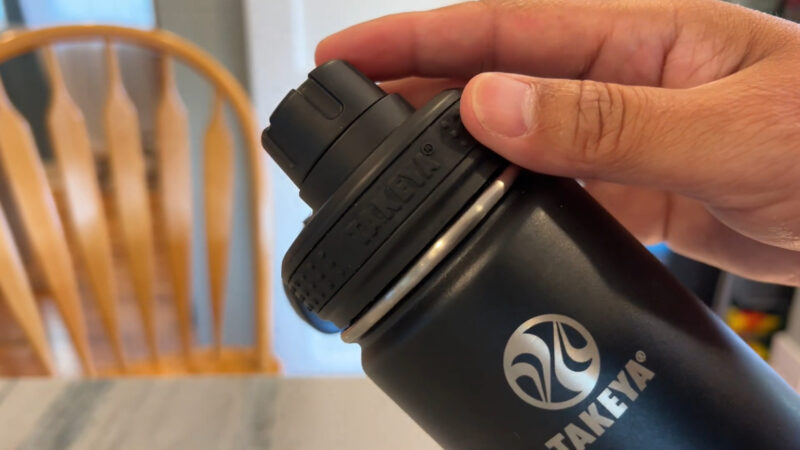
When it comes to selecting top-tier eco-friendly water bottles, two brands stand out for their quality and innovative designs: Hydro Flask and ThermoFlask.
- Hydro Flask: Hydro Flask has gained a remarkable reputation in the market for its exceptional insulation capabilities and sleek designs. The Hydro Flask bottles are designed with TempShield™ technology, an advanced form of double-wall vacuum insulation ensuring your drinks stay cold for up to 24 hours or hot for up to 12 hours. This feature is a game-changer for those who are constantly on the move and need their beverages at a consistent temperature. Moreover, Hydro Flask’s commitment to using BPA-free plastics and food-grade stainless steel aligns perfectly with eco-friendly standards.
- ThermoFlask: ThermoFlask, another leading brand in this segment, offers a range of insulated water bottles that are both durable and stylish. ThermoFlask bottles are known for their robust construction, making them a great companion for outdoor adventures. Similar to Hydro Flask, ThermoFlask utilizes double-wall vacuum insulation technology, which is perfect for keeping your beverages at the desired temperature for extended periods. Additionally, ThermoFlask’s emphasis on eco-friendly materials and sustainable production practices makes it a worthy choice for environmentally conscious consumers.
Both Hydro Flask and ThermoFlask have set high standards in the industry for combining functionality with environmental responsibility. When considering your next purchase, Hydro Flask and ThermoFlask should definitely be on your radar for their unmatched quality and commitment to sustainability.
Sustainability
In an effort to support environmental health, I focus on bottles that are produced with a lower carbon footprint.
| Factor | Description | Importance for Eco-Conscious Consumers |
|---|---|---|
| Resource Management | This refers to how the materials for the bottles are sourced and used. Companies focusing on sustainability might use recycled materials or responsibly sourced new materials. | Choosing bottles from companies that practice responsible resource management means supporting businesses that are mindful of their environmental impact. |
| Production Methods | The methods used to manufacture the bottles play a significant role in their environmental footprint. This includes energy consumption, waste management, and emissions during production. | Bottles produced with methods that minimize pollution and waste contribute to a lower carbon footprint and are more eco-friendly. |
| Carbon Footprint | The overall carbon footprint of a bottle includes not just production, but also transportation and distribution. | A lower carbon footprint indicates that the product has a lesser impact on global warming, making it a preferable choice for those who are environmentally conscious. |
| Company’s Environmental Policies | The broader environmental policies and commitments of the company, including their efforts in sustainability beyond just bottle production. | Supporting companies with strong environmental policies ensures that your purchase is contributing to broader environmental goals and sustainable practices. |
| Recyclability and End-of-Life Management | How the bottle and its components are disposed of or recycled at the end of their life cycle is crucial. | Bottles that are easily recyclable or biodegradable reduce environmental impact and waste, aligning with sustainable living principles. |
Price
It’s important to balance affordability with quality and sustainability. While a higher price doesn’t always equate to better sustainability, it often correlates with higher quality materials and more ethical production practices.
- Value for Money: Look for a water bottle that offers the best combination of features at a reasonable price. This includes durability, material quality, and eco-friendliness.
- Long-Term Investment: A slightly higher initial cost might lead to long-term savings if the bottle is more durable and doesn’t need to be replaced frequently.
- Features vs. Price: Evaluate what features are most important to you (e.g., insulation, material, design) and determine if the price aligns with these features.
- Sustainability Costs: Sustainable production methods, such as using recycled materials or renewable energy, might add to the cost but contribute positively to environmental conservation.
You should also be aware of the price range.
| Price Range | Expected Features | Typical Materials | Sustainability Aspect |
|---|---|---|---|
| Budget (Under $15) | Basic functionality, limited durability, fewer design options | Often plastic, lower-grade metals | Less focus on sustainability, may lack certifications |
| Mid-Range ($15 – $30) | Improved durability, more design choices, some insulated options | Higher quality plastics, stainless steel, some glass options | Often more sustainable practices, better quality materials |
| High-End ($30 – $50) | High durability, advanced features (e.g., superior insulation), unique designs | High-grade stainless steel, quality glass, advanced composites | Likely produced with sustainable practices, durable and eco-friendly materials |
| Luxury (Above $50) | Premium features, brand prestige, potentially custom designs | Premium materials, potential for innovative eco-friendly materials | High sustainability standards, often supports environmental initiatives |
FAQs
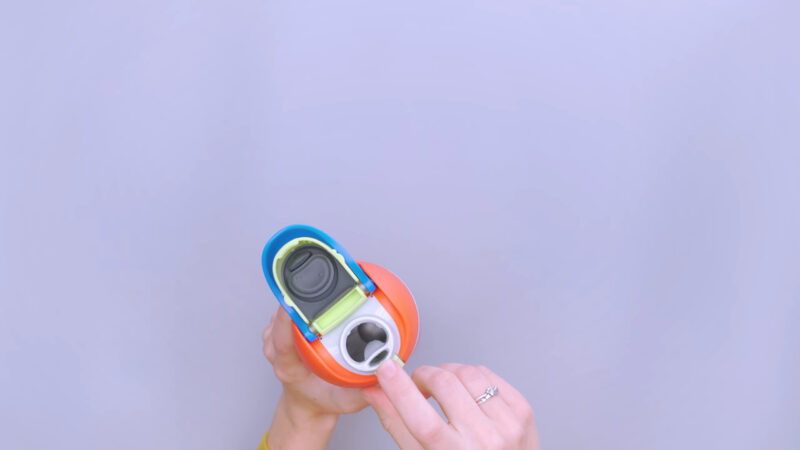
What is the most eco-friendly water bottle material?
Stainless steel stands out as the most eco-friendly water bottle material. It’s durable, endlessly recyclable, and doesn’t leach chemicals.
What is the most sustainable water bottle company?
Klean Kanteen is frequently recognized for its sustainability efforts. The company offers high-quality, reusable stainless steel bottles and is committed to responsible environmental practices.
What bottled water is 100% spring water?
Mountain Valley Spring Water offers bottles that are 100% natural spring water. The company sources its water from a single spring in Arkansas, ensuring the purity of its product.
Are aluminum water bottles eco-friendly?
Yes, aluminum water bottles are eco-friendly as aluminum is a recyclable material. They’re lightweight, require less energy to transport, and can be recycled an infinite number of times without loss of quality.
Is there a biodegradable water bottle?
While fully biodegradable water bottles are still an emerging market, brands like Choose Water have developed bottles made from natural materials designed to decompose within weeks after use. However, accessibility and availability of these bottles can be limited.
Conclusion
I recommend users consider lifecycle, manufacturing practices, and end-of-life disposability. To me, the perfect water bottle is one that balances these considerations while fitting into a sustainable lifestyle.
It’s clear that investing in a reusable bottle lessens the environmental toll of disposable plastics.
My suggestion is to choose a bottle that resonates with your values and lifestyle needs. Remember, the best eco-friendly bottle is the one you will use consistently, thereby reducing waste effectively.
Related Posts:
- Water Conservation 101: Practical Eco-Friendly…
- Why Should I Get an Electric Car - Eco-Friendly Solution
- Can Swimming Pools Be Eco-Friendly? Exploring…
- Jackpot for the Planet: Discover the Eco-Friendly…
- 10 Best Books on Climate Change in 2024 - In-Depth…
- 5 Best Tumbling Composters for Your Garden in 2024 -…








